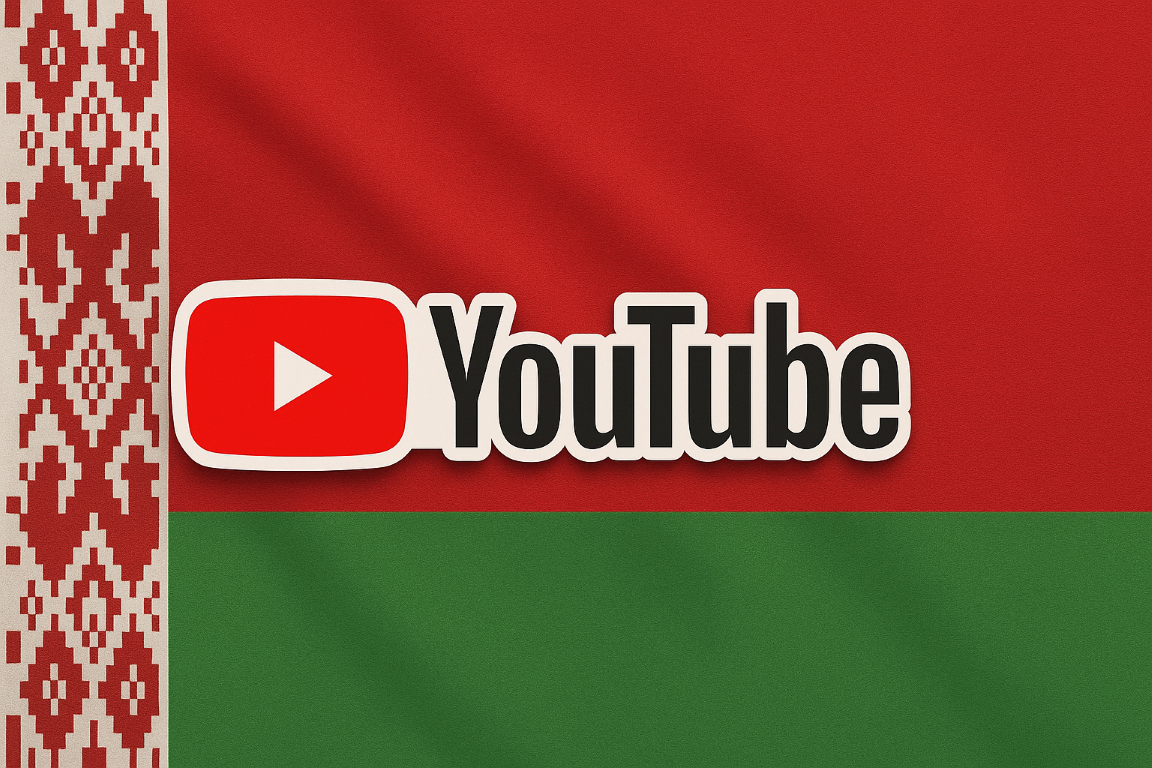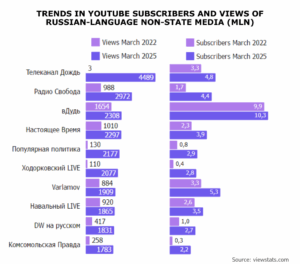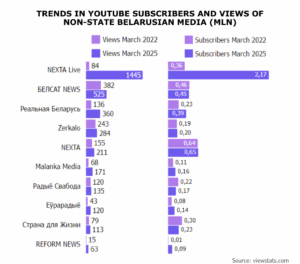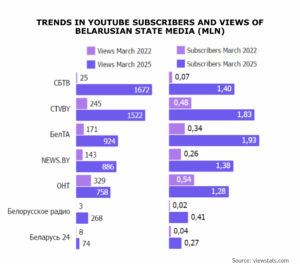
YouTube Restrictions on Belarus and Russia Strengthen Minsk’s Propaganda
YouTube Restrictions on Belarus and Russia Strengthen Minsk’s Propaganda
Executive Summary:
- Sanctions, blocks on international payment systems, and the suspension of monetization on YouTube have significantly undermined the financial sustainability of independent media channels in Belarus and Russia.
- Belarusian state media rapidly filled the vacuum left by Russian outlets that YouTube banned after Russia’s full-scale invasion of Ukraine in 2022, using aggressive advertising and Kremlin-style narratives to grow their audience.
- Independent Russian-language media saw initial growth after Russia’s full-scale invasion of Ukraine, but now face tightening censorship, throttled access, and financial isolation. With state media dominating alternative platforms, independent outlets rely increasingly on diaspora and international audiences to survive.
Russian Minister of Digital Development, Communications, and Mass Media Maksut Shadayev stated in a June 4 meeting with Russian President Vladimir Putin and other members of the Russian government that alternative Russian video platforms, VK Video and RuTube, are “demonstrating considerable progress.” He claimed that two-thirds of YouTube traffic has shifted to Russian platforms and that many Russian content creators from YouTube have moved to these platforms after their channels were blocked and deleted by YouTube last year (President of Russia, June 4). The restrictions imposed by YouTube on content from Russia and Belarus following Russia’s full-scale invasion of Ukraine in February 2022 have most negatively impacted independent bloggers and media outlets. The sanctions have made it more difficult for independent media, which previously relied on donations and advertising through YouTube, to expand their audiences and secure funding. On December 10, 2024, Google’s Ad Manager released a notice that Belarus-based AdSense, AdMob, and Ad Manager accounts would be deactivated, making it so accounts based in Belarus would not be able to monetize content (Google Ad Help Manager, posted December 10, 2024, accessed June 10; Belsat, December 11, 2024). YouTube’s monetization ban for Russian and Belarusian content creators exacerbates the shortage of information not funded by the state, making it more difficult to produce independent content.
The United States imposed sanctions on Russian state media following Russia’s full-scale invasion of Ukraine in 2022, leading YouTube to block and restrict their channels (U.S. Treasury Department, February 24, 2022; YouTube Studio App Help Center, posted February 25, 2024; accessed June 6; TASS, July 10, 2024). These restrictions on Russian accounts strengthened the presence of Belarusian state media on YouTube as they filled the vacuum left by Russian state media on the platform. The audience for Belarusian state media on YouTube has grown significantly over the past three years. On some channels, view counts have increased nearly 90-fold, and subscriber numbers have multiplied many times over (Sota, March 10). By March 2025, several Belarusian state television channels were ranked among YouTube’s top 10 most-viewed Russian-language channels (Sota, March 10).
The increased popularity of Belarusian state media on YouTube stems from Belarus’s substantial investment in propaganda, its repression of independent media, and the impact of YouTube’s restrictions on Russian state and independent media (see EDM, May 5, 2021, August 7, 2024, January 22, February 3). The repression of other viewpoints enables the Belarusian state media to control the information space, shape narratives favorable to the authorities, and suppress independent voices.
Before February 2022, Belarusian state channels remained on the margins of YouTube with relatively small audiences. After YouTube blocked Russian state media, Minsk quickly took advantage of the freed-up space, launching advertising campaigns that attracted viewers from Russia and possibly Ukraine (Sota, March 10). Belarusian state media reproduces Kremlin propaganda patterns and actively justifies Russia’s aggression against Ukraine (Pozirk, April 22; Belarusian Association of Journalists, May 13).
Independent media outlets reporting on Belarus have had mixed success on YouTube over the past three years. NEXTA remains the leader among Belarusian independent media, with an audience comprising Russian-speaking viewers from around the world (see EDM, September 20, 2020; YouTube/@NEXTALive, accessed June 6). At the same time, many independent channels have faced a decline in their audiences, likely due to increasingly repressive laws inside Belarus. Hundreds of media outlets have been designated as “extremist,” and subscribing to them can have consequences ranging from hefty fines to prison sentences of up to seven years (European Union vs Disinfo, August 9, 2022). Belarusian law enforcement regularly conducts raids to track down and punish followers of banned channels (Committee to Protect Journalism, April 30, 2024). At border crossings, officials routinely inspect mobile devices, and the discovery of a subscription to a banned media channel can result in immediate arrest (PEN Belarus, May 6)).
Many Belarusians avoid officially subscribing to so-called “extremist” YouTube channels, opting instead to watch anonymously or refrain from consuming banned content to minimize the risk of legal consequences (SB.BY, April 24). Political apathy is growing within society, with people shifting their attention to entertainment content that covers less sensitive topics (Bolkunets, “Interests of Belarus residents by search queries in Google and Yandex,” October 9, 2023). Additionally, the reduction of U.S. funding for independent media in Russia and Belarus is likely to strengthen the position of state-run outlets further (see EDM, April 21). Many independent media outlets may be forced to scale back their activities or shut down entirely.
Russian opposition media on YouTube, such as the Popular Politics and Khodorkovsky LIVE channels, saw an approximately 18-fold increase in viewership following Russia’s full-scale invasion of Ukraine in 2022, driven by a surge in demand for alternative information sources (Social Blade, Popular Politics, Khodorkovsky LIVE, accessed June 10). Nevertheless, the audience for independent Russian-language outlets on YouTube remains significantly smaller than that of state-run channels, which enjoy extensive resources for promoting content through a vast network of platforms. A German study estimates about 10 million users of independent Russian-language media, with around 5–8 million in Russia (JXFUND, December 5, 2023). According to rough estimates, the core audience of the largest independent socio-political YouTube channels in Russia numbers around 20–25 million people, with substantial overlap between their viewers (Levada, June 7, 2024; RMAA, February 18).
Trends in YouTube subscribers for Belarusian media, compiled by the author:





Russia has tightened restrictions on YouTube in recent years, partially blocking the site in retaliation for YouTube’s sanctioning of state-run channels and to limit public access to independent sources of information. The Kremlin’s slowdown of the platform’s performance has forced users to rely on virtual private networks (VPNs) or migrate to state-affiliated video sites, such as RuTube and VK Video (Lenta, July 25, 2024; SecurityLab.ru, August 10, 2024; President of Russia, June 4). State-controlled media, armed with extensive resources, are actively strengthening their position on these alternative video platforms, thereby further dominating the information space. (For example, see VKontakte/@rt_russian; RuTube/@rtrussian, accessed June 10.)
Many independent Russian-language YouTube channels have likely reached the peak of their audience growth, with further expansion dependent on producing higher-quality, original content. Independent outlets risk losing a significant portion of their Russian audience due to heightened censorship and the potential for YouTube to be fully blocked in Russia (Meduza, December 23, 2024). They will likely maintain influence, however, through support from the diaspora and international audiences. Their impact inside Russia will likely stabilize or gradually decline, as has already been the case in Belarus.
Since 2022, YouTube has imposed strict restrictions on Russia and Belarus, including a complete suspension of monetization for all users and content creators from these countries (YouTube Help, posted August 12, 2022, accessed June 10; Google Ad Help Manager, posted December 10, 2024, accessed June 10). This cut-off affects advertising revenue, mainly impacting independent creators whose advertising income had been their primary source of income.
Financial sanctions made it nearly impossible for channel owners using Russian banks to receive donations after Russia’s full-scale invasion of Ukraine. The blocking of international payment systems, combined with government-imposed fines for supporting independent media, deprived many bloggers and outlets of key funding sources (European Commission, March 1, 2022; Mediazona, January 10). As a result, their activity, growth, and sustainability sharply declined. Funding constraints forced some independent voices to leave YouTube entirely or drastically scale back their presence, further strengthening the dominance of state-run media (The Moscow Times, July 30, 2024).
YouTube’s restrictions on Russian creators have not weakened propaganda and, in some cases, have even contributed to its expansion. Belarusian state-run outlets gained room to grow, while independent media and bloggers faced increasing pressure from both the authorities and platform policies. The challenges faced by Belarusian and Russian independent media extend beyond consumer access to their sites. Outlets struggle to organize interviews because experts and public figures fear repercussions for speaking publicly, which undermines the quality and independence of journalism.
Over the past three years, two parallel realities have solidified in the information space. Within Belarus and Russia, state-controlled media shape narratives that align with official agendas. Meanwhile, independent creators often working in exile operate under censorship and constant repression from their governments while also suffering from Western sanctions meant to punish Russia’s full-scale invasion of Ukraine. Independent media still holds the potential to maintain influence through diaspora communities and international audiences, but their reach within their home countries is likely to either remain stagnant or continue to decline.


